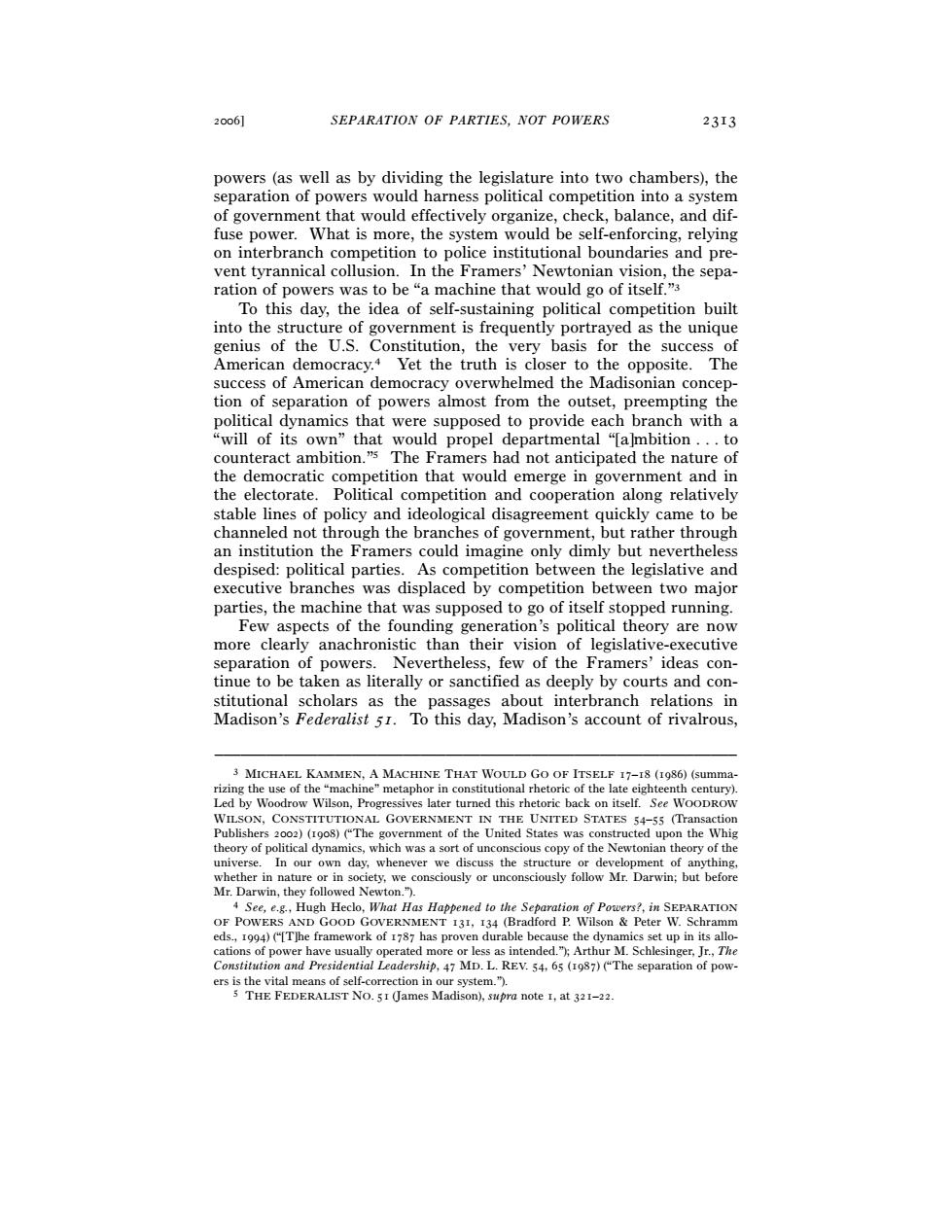正在加载图片...

2o06] SEPARATION OF PARTIES,NOT POWERS 23I3 powers (as well as by dividing the legislature into two chambers),the separation of powers would harness political competition into a system of government that would effectively organize,check,balance,and dif- fuse power.What is more,the system would be self-enforcing,relying on interbranch competition to police institutional boundaries and pre- vent tyrannical collusion.In the Framers'Newtonian vision,the sepa- ration of powers was to be "a machine that would go of itself."3 To this day,the idea of self-sustaining political competition built into the structure of government is frequently portrayed as the unique genius of the U.S.Constitution,the very basis for the success of American democracy.4 Yet the truth is closer to the opposite.The success of American democracy overwhelmed the Madisonian concep- tion of separation of powers almost from the outset,preempting the political dynamics that were supposed to provide each branch with a “will of its own”that would propel departmental“[a]mbition...to counteract ambition."5 The Framers had not anticipated the nature of the democratic competition that would emerge in government and in the electorate.Political competition and cooperation along relatively stable lines of policy and ideological disagreement quickly came to be channeled not through the branches of government,but rather through an institution the Framers could imagine only dimly but nevertheless despised:political parties.As competition between the legislative and executive branches was displaced by competition between two major parties,the machine that was supposed to go of itself stopped running. Few aspects of the founding generation's political theory are now more clearly anachronistic than their vision of legislative-executive separation of powers.Nevertheless,few of the Framers'ideas con- tinue to be taken as literally or sanctified as deeply by courts and con- stitutional scholars as the passages about interbranch relations in Madison's Federalist 51.To this day,Madison's account of rivalrous, 3 MICHAEL KAMMEN,A MACHINE THAT WOULD GO OF ITSELF 17-18(1986)(summa- rizing the use of the "machine"metaphor in constitutional rhetoric of the late eighteenth century) Led by Woodrow Wilson,Progressives later turned this rhetoric back on itself.See WooDRoW WILSON,CONSTITUTIONAL GOVERNMENT IN THE UNITED STATES 54-55(Transaction Publishers 2002)(19o8)("The government of the United States was constructed upon the Whig theory of political dynamics,which was a sort of unconscious copy of the Newtonian theory of the universe.In our own day,whenever we discuss the structure or development of anything, whether in nature or in society,we consciously or unconsciously follow Mr.Darwin;but before Mr.Darwin,they followed Newton."). 4 See,e.g.,Hugh Heclo,What Has Happened to the Separation of Powers?,in SEPARATION OF POWERS AND GOOD GOVERNMENT 131,134 (Bradford P.Wilson Peter W.Schramm eds.,1994)("[TJhe framework of 1787 has proven durable because the dynamics set up in its allo- cations of power have usually operated more or less as intended.");Arthur M.Schlesinger,Jr.,The Constitution and Presidential Leadership,47 MD.L.REV.54,65 (1987)("The separation of pow- ers is the vital means of self-correction in our system."). 5 THE FEDERALIST No.5I (James Madison),supra note I,at 321-22.2006] SEPARATION OF PARTIES, NOT POWERS 2313 powers (as well as by dividing the legislature into two chambers), the separation of powers would harness political competition into a system of government that would effectively organize, check, balance, and diffuse power. What is more, the system would be self-enforcing, relying on interbranch competition to police institutional boundaries and prevent tyrannical collusion. In the Framers’ Newtonian vision, the separation of powers was to be “a machine that would go of itself.”3 To this day, the idea of self-sustaining political competition built into the structure of government is frequently portrayed as the unique genius of the U.S. Constitution, the very basis for the success of American democracy.4 Yet the truth is closer to the opposite. The success of American democracy overwhelmed the Madisonian conception of separation of powers almost from the outset, preempting the political dynamics that were supposed to provide each branch with a “will of its own” that would propel departmental “[a]mbition . . . to counteract ambition.”5 The Framers had not anticipated the nature of the democratic competition that would emerge in government and in the electorate. Political competition and cooperation along relatively stable lines of policy and ideological disagreement quickly came to be channeled not through the branches of government, but rather through an institution the Framers could imagine only dimly but nevertheless despised: political parties. As competition between the legislative and executive branches was displaced by competition between two major parties, the machine that was supposed to go of itself stopped running. Few aspects of the founding generation’s political theory are now more clearly anachronistic than their vision of legislative-executive separation of powers. Nevertheless, few of the Framers’ ideas continue to be taken as literally or sanctified as deeply by courts and constitutional scholars as the passages about interbranch relations in Madison’s Federalist 51. To this day, Madison’s account of rivalrous, ––––––––––––––––––––––––––––––––––––––––––––––––––––––––––––– 3 MICHAEL KAMMEN, A MACHINE THAT WOULD GO OF ITSELF 17–18 (1986) (summarizing the use of the “machine” metaphor in constitutional rhetoric of the late eighteenth century). Led by Woodrow Wilson, Progressives later turned this rhetoric back on itself. See WOODROW WILSON, CONSTITUTIONAL GOVERNMENT IN THE UNITED STATES 54–55 (Transaction Publishers 2002) (1908) (“The government of the United States was constructed upon the Whig theory of political dynamics, which was a sort of unconscious copy of the Newtonian theory of the universe. In our own day, whenever we discuss the structure or development of anything, whether in nature or in society, we consciously or unconsciously follow Mr. Darwin; but before Mr. Darwin, they followed Newton.”). 4 See, e.g., Hugh Heclo, What Has Happened to the Separation of Powers?, in SEPARATION OF POWERS AND GOOD GOVERNMENT 131, 134 (Bradford P. Wilson & Peter W. Schramm eds., 1994) (“[T]he framework of 1787 has proven durable because the dynamics set up in its allocations of power have usually operated more or less as intended.”); Arthur M. Schlesinger, Jr., The Constitution and Presidential Leadership, 47 MD. L. REV. 54, 65 (1987) (“The separation of powers is the vital means of self-correction in our system.”). 5 THE FEDERALIST NO. 51 (James Madison), supra note 1, at 321–22